Abstract
The current article analyzes the impact of charging electric vehicles and battery energy storage systems on the photovoltaic hosting capacity of low-voltage distribution networks. A Monte Carlo-based simulation is used to analyze predominantly rural, intermediate and predominantly urban residential regions facing different penetrations of electric vehicles utilizing uncontrolled and controlled charging, and evaluate their impact on photovoltaic hosting capacity. Subsequently, electric vehicles are replaced or supplemented by residential battery energy storage systems, and their combined impact on the hosting capacity is studied. The results revealed that electric vehicles solely do not improve the hosting capacity unless they are connected to the network during sunshine hours. However, controlled storage provides a remarkable increase to the hosting capacity and exceptional contribution in combination with electric vehicles and customers with high loads. Finally, a feasibility analysis showed that controlled charging of the storage has a lower marginal cost of increasing hosting capacity as compared to network reinforcement.
1. Introduction
Thanks to the inexpensive combustion of fossil fuels, humanity has taken a huge step forward in the advancement of society. However, to prevent negative effects on the environment, new energy sources with lower climate impact should be exploited. The rapid decrease in prices leads to photovoltaic (PV) technology being a competitive solution for energy generation [1]. Given their advantages, such as clean electricity production, price competitiveness and the usage of otherwise unused roof area, the expansion of PV generation is expected in the future. Moreover, the COVID-19 pandemic and the Russian invasion of Ukraine have accelerated the shift toward the utilization of renewable energy in Europe. The hosting capacity (HC) term has been defined to quantify the amount of distributed energy sources that can be integrated into networks, and the term is under discussion in the current study.
The necessity for a more sustainable way of life changes other industries, which, although not previously closely linked to electricity, now present new challenges and opportunities for utilities, such as transportation, where electric vehicles (EV) have increased their share of the market in recent years. In addition to the spread of battery-powered vehicles, battery energy storage systems (BESS) for home use became available on the market. The power production of PV systems and other renewable energy sources is inherently intermittent and electricity production solely based on unstable renewables usually cannot effectively support consumption. The accumulation of redundant electricity and its usage in the time of production deficit contributes to grid resilience and is also a matter of discussion in the current study.
The topic was studied in the literature previously; for instance, in [2], a test network with PV, BESS and EV charging stations was presented. The operation of the network was optimized by a multi-objective technique with the objective to maximize daily revenue of the EV charging station and minimize the costs. The presented framework provides great comprehension; however, the HC was left out of the scope of work. A framework combining PV, EV and BESS was presented in [3] to evaluate the cumulative impact on the network. A simulation of a single network was accompanied with measured data. Even though different EV and BESS charging scenarios were simulated, an impact on HC remained unstudied.
The combined effect of EVs and energy storage on PV HC has been studied in numerous works. In [4], the PV HC was analyzed as a function of EV penetration under different charging scenarios and pricing schemes. The study concluded that EVs can indeed increase PV HC, but at the price of higher losses and unbalance. However, supposedly due to the cooling load, the pricing scheme of the test case had high price at noon hours, which is not common for North European areas. In [5], a Monte Carlo-based assessment of energy storage impact on hosting capacity in realistic Finnish low-voltage networks was employed. Several scenarios for different regions were investigated to reveal the increase of self-consumption of single-phase PV-produced energy by installing a BESS. A case study of a typical Czech network was showcased in [6]. Authors modeled the BESS and EV impact of PV HC, as well as PV inverter P and Q control. The study emphasized the benefit of PV generation control at the generation site. Even though the analysis utilized measured data, the case networks are focused on the application of particular networks in the Czech Republic. Similarly, a lab setup was built to test renewable energy sources with EV and BESS control strategies in [7]. The results indicated that a higher load grants higher HC values in distribution networks. The significance of the load impact on the HC was studied in [8], employing the example of plug-in electric vehicles. The results of large-scale network simulations showed that increasing penetration of plug-in electric vehicles (PHEVs) raises operation costs from a distribution system operator (DSO) point of view and emphasizes the importance of smart charging on the HC. Recently, the authors of [9] proposed an optimization-based solution for network overload reduction caused by large-scale EV charging. The study showcased that a decentralized control of EV charging can improve the EV hosting capacity and highlighted that a longer planning horizon for charging reduces charging anxiety, and users accept a lower charging power.
Elaborating on the topics highlighted above, in this article, the effect of EV and BESS on PV HC in low-voltage distribution networks is studied. A Monte Carlo simulation model is utilized to generate numerous scenarios of PV, EV and BESS deployment, as well as customer load variations. Uncontrolled and controlled charging scenarios of both EV and BESS operation are presented to evaluate their impact of the HC, and a combined scenario is modeled to reveal the synergy of combined PV-EV-BESS operation. Power quality and network capacity violation check is backed-up by the load flow calculations. This study analyzes the capabilities of Finnish low-voltage distribution networks of three customer density areas: predominantly rural, intermediate and predominantly urban. In summary, our work can promote practical applications for networks of the future in Finland with the contributions of this article as follows:
- A comprehensive analysis of the various electric energy assets and their combined effect on PV HC. The Monte Carlo simulation employed reduces the number of assumptions made for each of the assets by considering the inputs as probability distributions. As compared to other research with isolated cases, the probabilistic approach requires fewer assumptions to be made. The accuracy of the model depends instead on the input data, which were acquired from local sources for the current study.
- We present sensitivity analyses on the selected parameters of the energy assets related to EV availability and home storage capacity. Moreover, we demonstrate a comparative analysis of network reinforcement to household energy storage.
The workflow, network load and EV arrival generation, as well as main assumptions of the simulation are described in Section 2. The results of different deployment strategies of EV and BESS are presented in Section 3, followed by the sensitivity analyses of EV availability and BESS capacity in Section 4, and BESS feasibility analysis in Section 5. Finally, the conclusions are drawn in Section 6.
2. Methodology
In this section, the main steps of the workflow, vehicle demand modeling and main assumptions are described.
2.1. Framework
In this study, PV HC is examined by Monte Carlo-based simulations. The proposed framework is based on the approach presented in [5], and can be summarized as follows:
- Generate LV network.
- Initialize PV power output.
- If applicable, simulation EV and/or BESS behavior.
- Search for the worst hours with respect to PV HC.
- Run load flow analysis of the worst hours.
- If there are any power quality or network capacity violations, then follow to Step 7, else increase the PV power output and return to Step 3.
- If last iteration, then end the simulation, else continue with the next iteration by following to Step 1.
2.1.1. Search within an Iteration
When an iteration is initialized and all random variables (such as consumption of households, number of electric vehicles, etc.) are assigned according to the respective probabilities, a search for PV HC within the iteration begins. In this search, every customer is assigned a balanced 3-phase PV system, in which the rated power is increased step by step. The increase of the generation is evenly distributed by incrementing the power of all the customers at the same time. The PV rated power is then transformed into an hourly time series of PV power based on the research in [10]. Following the approach in [5], the final one-year PV power curves correspond to PVs located in the Helsinki area, Finland, tilted at a 45° angle and oriented to the south. The PV generation can be split into two components. The first component is deterministic and is based on the geometry of the Earth and Sun. The stochasticity of the PV generation is encapsulated in the second component, that represents the snowfall and cloud coverage of a PV plant, and strictly decreases the power output of a panel. The stochastic component, however, is neglected in the current study due to the search for the highest possible PV generation at any time instance. The utilized PV waveform represents the solar generation, neglecting possible weather conditions hindering irradiation.
2.1.2. The Worst Hours
In this study, a yearly time series on an hourly basis are utilized to estimate the HC. Yet, checking every hour would still be demanding, and the added value would not correspond to the computational time. In order to avoid conducting the load flow analysis for every hour of the year, a limited number of hours are selected for the remainder of the procedure. The selected hours are chosen to reflect the most critical points with the highest PV generation-to-load ratio and are further called the worst hours (WH). First, load in every node is analyzed and the hours, where the difference between PV production and load is the highest, are found. EV and BESS charging/discharging power is added to the household load at every node to find the difference to the PV generation in the following steps of the analysis. Secondly, in order to limit the number of analyzed hours even further, another selection among these hours is conducted; thus, hours for the final analysis are selected.
As an example, to detect the WHs, the algorithm was set to find the 1000 worst hours in the intermediate (IN) region facing uncontrolled charging. Their distribution between hours in a day is shown in Figure 1. The results hint that the most critical hours are concentrated around noon. This is credible since the production of PV systems peaks around noon and so this part of the day is essential from the PV HC point of view. The number of worst hours to which compliance with the limits should be checked has been studied. The algorithm has been found to be very efficient in finding the most critical hours, and so very few hours need to be analyzed to find the limiting PV HC. Therefore, simulations in this analysis analyze the 7 most commonly occurred worst hours.

Figure 1.
Distribution of selected hours in a day.
2.1.3. Violations
Electricity supply has to comply with quality regulations and limiting parameters of the network. As in [5], the following constraints and their coding are considered in the current study:
- Load flow not converged (E1);
- Undervoltage (E2);
- Overvoltage (E3);
- Negative sequence voltage unbalance (E4);
- Cable ampacity exceeded (E5);
- Neutral wire ampacity exceeded (E6);
- Transformer capacity exceeded (E7).
The voltage quality in Europe is regulated by standard EN 50160, which allows ±10% voltage change from the nominal. However, the limits may vary from country to country and, for example, the German LV guidelines [11] require the maximum voltage rise at the point of common coupling to be below 3%. Naturally, considering larger violation band may result in overestimation of HC [12]. Therefore, voltage bands −5/+3% from the German standard are assumed. The limitation for negative sequence voltage unbalance is 2% of the positive sequence voltage, as per EN 50160.
2.1.4. Data Selection
The study is focused on the investigation of a typical environment of Finland and the challenges that distribution networks might face in the future. This interest is extended further into the basis of the data selection. Distribution networks represent typical networks of Finland and the network parameters are of the largest vendors available locally. The measured household demand and solar generation correspond to the capital region, while the EV demand generation is based on the reports of the Finland traffic authorities. The exact sources of the data are listed in corresponding sections.
2.2. Load and Network Modeling
The study employs Finnish low-voltage distribution networks introduced in [5,12], which are divided by Eurostat’s classification method that divides countries into smaller regions based on the nomenclature of territorial units of statistics nomenclature of territorial units of statistics (NUTS). The 3 NUTS regions, which are under scrutiny, are classified as follows [12]:
- Predominantly rural (PR);
- Intermediate (IN);
- Predominantly urban (PU).
For each region, an LV distribution network was designed. A general structures of these networks, corresponding to the ones in [5] are presented in Table 1. The networks correspond to parameters collected in a survey of a distribution network company in Finland. The proposed networks are powered by transformers of the same power ratings as in [5]. Due to a myriad of different transformer types feeding distribution networks, average transformers of corresponding power ratings are picked from the list of ABB’s liquid-filled distribution transformers [13]. These specifications are shown in Table 2. Network nodes and transformers are interconnected by AXMK cables of the same lengths as in [5,12]. Their specification is based on Prysmian Group’s data-sheet [14] and is summarized in Table 3.

Table 1.
Network parameters of the simulated regions.

Table 2.
Transformer specifications.

Table 3.
Cable specifications.
An overall view of the simulated LV distribution network of the IN region is shown in Figure 2. However, unlike the network topology, which for a given region is the same, the household consumption in each node and iteration differs. This is caused by the random assignment of household load profiles to each customer. This study follows the approach of [12] and utilizes three measured household load profiles from [15] differentiated by the heating mode of a household. These profiles, in the form of hourly data series for one year, replicate household consumption with electric storage heating (SH), district heating (DH) and direct electric heating (DEH). Heating mode distribution across the regions is based on [12], and is presented in Table 4. The loads are assumed to be balanced three-phase.
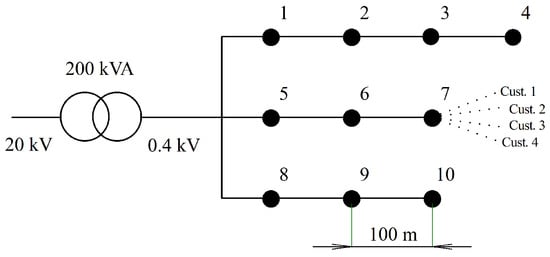
Figure 2.
Diagram of the distribution network in the IN region.

Table 4.
Heating modes across the regions.
2.3. Electric Vehicle Modeling
Predictions of passenger car (PC) fleet development in Finland can be found on the Finnish Information Center of Automobile Sector websites. According to it’s Automotive Propulsion Roadmap [16] from 2021 with predictions until 2040, a significant increase of EVs can be expected. In 2030, battery electric vehicles (BEV) and PHEV are expected to represent 54.5% of all newly registered passenger cars and 19.5% of the whole automobile fleet. The share is expected to grow even further by 2040, when the share of newly registered passenger cars rise up to 65.8% resulting in 42.3% of the whole PC fleet being EVs. Table 5 summarizes the selected EV penetration levels for the analysis. The first two penetrations follow the predictions for PC fleets in Finland for two years in the relatively close future—2030 and 2040. The last case of EV penetration is to study the impact of EV charging if each customer has a battery-powered automobile. Note that in this study, only BEVs and PHEVs are considered as EVs. Hybrids without the ability to be charged from the grid are not considered to be EVs, as they do not participate in power exchange with distribution networks.

Table 5.
Simulated EV penetration levels.
2.3.1. Electric Vehicle Fleet
The impact of charging of EVs is significantly affected by the structure of the EV fleet. The current study utilizes the currently best-selling cars, and due to the differences in the EV sales throughout the year and the availability of data, the proposed EV fleets are based on the most frequently newly registered BEVs and PHEVs in the EU in 2020. As these EVs are the cornerstones of the simulated EV fleets, the shares of their sales among the top 10 vehicles in their category were calculated and selected from the data presented in the report [17]. Since the stochastic Monte Carlo-based simulation is used to find PV HC, the proportion of sales among the top 10 vehicles in the corresponding category represents the probability that a household will have this particular car. These probabilities for both BEVs and PHEVs are shown in Figure 3. Based on the aforementioned EV models, the electrical characteristics are summarized to model the EV network demand. Data was collected from the manufacturers web sources. Battery sizes and on-board charger limitations of BEVs and PHEVs are shown in Figure 4.
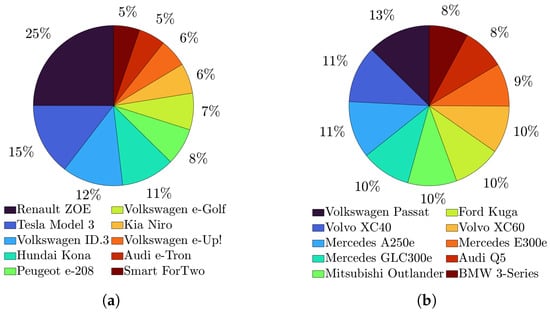
Figure 3.
Share of individual sales in the total sales of top 10 models of BEV and PHEV. (a) BEV. (b) PHEV.

Figure 4.
Top 10 BEVs (a) and PHEVs (b)—Usable batteries and on-board charging limitations.
2.3.2. Home EV Chargers
Although AC charging power is limited by the on-board charger, not every customer can be expected to use the fastest charging allowed by the EV. The issue of the distribution of charging power in households was addressed, for example, in [18], where 5 charging powers—3.7 kW, 6.9 kW, 11 kW, 17.25 kW and 22 kW—were assigned a certain probability to be used in predictions of impact of EV charging on power requirements. However, the study did not distinguish the differences between 1-phase and 3-phase chargers, for example, 1-phase 7.4 kW charger is not considered, even though it is a common charger power limit as can be seen in Figure 4. Unlike [18], this study distinguish 1-phase and 3-phase chargers and, therefore, charger types and their probabilities were slightly modified. First, the probability of a 3-phase charger 6.9 kW was divided between two chargers of similar powers—1-phase 7.4 kW and 3-phase 6.9 kW. Secondly, due to the very low representation of only 2% of all chargers, the 17.25 kW charger was neglected and its share was divided between 11 kW and 22 kW chargers. The charger types and their distribution in this study is summarized in Table 6.

Table 6.
Overview of EV chargers.
In order to project the distribution of the chargers into the simulations within the EV on-board charger limitations, all assumed EV models (10 BEVs and 10 PHEVs presented in Figure 3) were divided into 4 categories based on the on-board charger limitation. Charger powers were rounded to the nearest charger power to match the on-board charger limitations in case the on-board charger limitation did not correspond exactly to the modeled categories. For instance, EVs with a charging power limitation of 7.2 kW were assigned to the 7.4 kW category. Each of the 4 categories was allotted certain probabilities of available chargers, which are shown in Figure 5. In summary, a randomly sampled EV, from Table 5 and Figure 3, has an on-board charger and a battery with parameters from Figure 4, and is assigned to a customer with a home charger of power sampled from Figure 5.
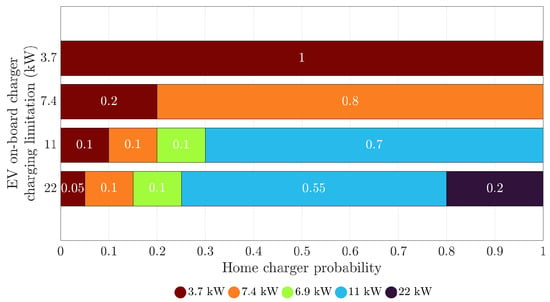
Figure 5.
Distribution of home chargers based on EV model and its on-board charger.
2.3.3. Behavior of Finnish Drivers
The behavior of Finnish drivers with a focus on residential areas has been described in [19]. Following their approach, the arrival times of EVs in this study were obtained by fitting a Gaussian distribution to hourly traffic measurements in Southern Finland roads and delaying it by one hour as the time of arrival is supposed to culminate slightly later than the traffic. The probability density function obtained by this approach has a mean = 16.53 h and standard deviation = 3.99 h.
In addition to the arrival time, an estimation of the daily driving distance is presented in [19]. Then, based on the article [20] and the Finnish Transport and Communications Agency Traficom, according to which the mean daily distance driven in Finland is approximately 46 km [21], a lognormal density function with parameters = 3.742 and = 0.4161 corresponding to an average daily driven distance 46 km and a standard deviation of approximately 20 km was used. The probability density functions of the time of arrival and daily mileage are visualized in Figure 6.
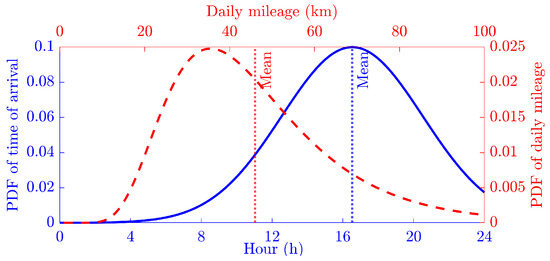
Figure 6.
Probability density functions (PDFs) of arrival time and daily mileage.
2.3.4. Electric Vehicle Average Consumption
In order to determine the amount of energy corresponding to daily mileage, consumption per one kilometer and charger efficiency are modeled based on the analysis presented in [22], where monthly average energy consumption in three Finnish cities was studied. The average consumption in the Helsinki area is utilized to calculate the total energy demand of EVs followed by the distance driven during a day. A 95% charging efficiency is considered in the current study to cope with the average energy consumption shown in Figure 7.
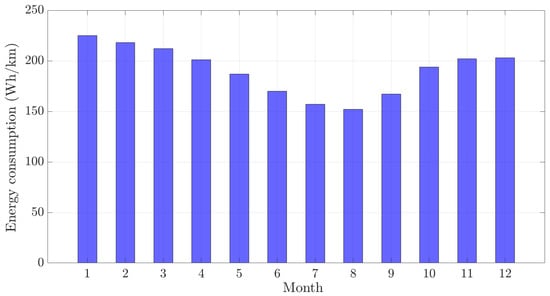
Figure 7.
Average EV energy consumption in Helsinki [22].
2.3.5. Electric Vehicles Key Modeling Assumptions
The key assumptions made during the EV modeling are listed in the following subsection. Although the exact charging behavior of EVs depends on the charging mode, the general rules are the same for all modeled EVs. These general rules include:
- Simulations are conducted as per the year of 2020, changes due to COVID-19 pandemic are neglected.
- EVs are used for travelling and later charged back at home once a day. Multiple trips in one day are not considered.
- EV is used every day, unless stated otherwise.
- Only weekdays are consider. All EVs disconnect at 7:00 and connect back later that day, unless stated otherwise.
- If a randomly assigned daily mileage and the associated energy consumption exceed the energy available in the battery, external charging (i.e., charging on highway, work place, etc.) is assumed. For the external charging, the state of charge (SoC) on arrival is 20%.
- Charging/discharging efficiency is 95%.
The simulation based on [23] is used to imitate uncontrolled charging of EVs under the following condition: EVs charge at 100% charger power until it is fully charged regardless of the conditions in the network. Controlled EV charging allows changes in charging power based on the programmed strategy. In this study, the charging strategy based on the vehicle-to-grid mode with the ability to increase PV HC proposed under the following rules:
- The EV starts charging as soon as it is connected to the grid until the state of charge of 80% is reached.
- At midnight, a forecast is made for the following day to see if EV is going to be used. If it is expected to be used, the further charging is allowed and 80%-SoC limit will be exceeded. This ensures that EV will be fully charged for the expected trip. When the EV is expected to remain connected throughout the day, the EV starts to charge/discharge to reach SoC 80%. This ensures the free capacity of the battery around the peak of PV production.
- PV surplus after 10:00 can be used to charge EV even when the battery SoC is over 80% to absorb excessive PV production.
2.4. Storage Modeling
The battery energy storage systems are utilized in the current study to model the home electrical storage. These systems can be called behind-the-meter (BTM) batteries as they are places at a customer’s facility and are beyond direct control of the distribution network operator. Based on [24], the size of the BTM battery can vary from 3 kW to 5 MW. Residential customers’ battery type, which are the only ones considered in this study, can typically reach 5 kW/13.5 kWh. Therefore, these values are used to represent a typical home battery. In order to reduce the degradation, the battery SoC and the usable capacity are restricted. In this study, BESSs operate under the following conditions:
- Only residential BESSs are considered.
- BESS discharging is preferred over the import from the network.
- BESSs are charged only by PV surplus after 10:00.
- Only 80% of total BESS capacity can be used, i.e., BESSs operate between SoC 10–90% [25].
- BESSs can charge/discharge independently in every phase with 1/3 of total rated power.
- Charging/discharging efficiency of BESSs corresponds to EV charging efficiency—95%.
An analysis was done in order to find the most suitable hour for beginning the BESS charging. The goal is to choose the right moment which would match with the excessive PV generation and absorb the surplus. Eight hours were tested in order to identify which hour between 7 and 14 would yield the highest increase in HC. Figure 8 shows how the HC is dependent on the beginning hour of the BESS charging and solar surplus utilization. As the figure hints, the most appropriate hours to allow BESSs charging is 10:00, as it yields the highest increase of the HC. Other simulated hours do not affect the HC due to smaller available storage capacity (caused by early charging) or by missing the noon’s peak of PV production (hours after the noon). In the current study, two charging strategies are defined. The uncontrolled charging encapsulates the aforementioned conditions. On the other hand, the controlled charging will force a BESS to discharge before 10:00.
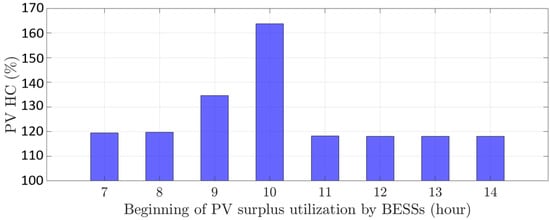
Figure 8.
Analysis of the most suitable hour allowing BESSs to use PV surplus; IN region; 100% penetration of 5 kW/13.5 kWh BESSs; 500 iterations per case.
3. Results
In this section, the results of the simulations are presented. First, the reference case HC is shown, then it is compared to the cases with EV and BESS. Thirdly, all the three devices are present in a single simulation to reveal the possible synergy in HC increase. Finally, a sensitivity analysis of BESS is performed. In the current study, the HC is defined as a ratio of peak PV generation and feeding secondary transformer rated power, and values shown in percents.
3.1. Reference Case
In this study, the reference case consists of households equipped with photovoltaics. The HC levels and their respective limiting factors of the three regions are shown in Table 7. The exact distribution of the HC values are shown in the subplots of Figure 9. The HC values follow normal distribution with the mean values presented above. In the PR region, the HC values range from 28% to 48%, 108% to 124% in IN region, while the range is smaller in the PU region, reaching from 85% to 89%. The dominating constraint is overvoltage (E3) for all the regions, except for IN region, where the transformer capacity (E7) was the main concern for the 91% of simulated tries. Note that few limiting factors occurred in a single simulation and due to that reason the sum of percentage values of limiting constraints exceeds 100%. Moreover, as Figure 10 hints, the HC has a linear dependency on the underlying load values in all the regions.

Table 7.
PV HC of networks in reference case (Overvoltage (E3), Transformer capacity (E7)).

Figure 9.
PV HC of the reference case; 1000 iterations (Overvoltage (E3), Transformer capacity (E7)). (a) PR. (b) IN. (c) PU.

Figure 10.
PV HC to load of the reference case; 1000 iterations (Overvoltage (E3), Transformer capacity (E7)). (a) PR. (b) IN. (c) PU.
An example of the total load of the transformer during the year in the IN region at the PV HC is visualized in Figure 11. The figure clearly shows the mixed character of low voltage distribution networks with PV systems at the point of HC. A striking contrast noticeable in summer, when at the beginning and the end of the day the network has to supply around 20 kW of power, and in the middle of the day it would have to absorb approximately 200 kW of PV surplus.
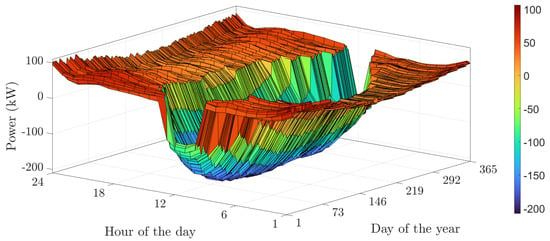
Figure 11.
Example of the total load of the transformer in the reference case; IN region; PV generation at the point of HC of 118.2% (236 kWp).
3.2. Uncontrolled Charging of EVs
The uncontrolled charging of EVs involves no cooperation between the grid and EVs. The beginning of the charging is initiated only by the time of arrival and by connection of the EV to the grid. Charging power depends only on the parameters and behavioral characteristics of the chargers and is not limited by the network.
The HC is near the reference case values elaborated in Section 3.1 and are shown in Table 8. In the PR region, the PV HC on average is around 37% for all PC fleets. In the IN region, the average PV HC is seemingly weakly growing with the EV penetration from 118.2% to 119.3%. Finally, in the PU region, a slight increase of PV HC caused by uncontrolled charging of EVs has been observed as well, but remained within a 2% increase. The decisive constraint in PR is still overvoltage (E3). The results of the IN region for the highest EV penetration—PC fleet All BEVs—indicate that the vital constraint is transformer overloading (E7), but growing EV penetration foster overvoltage issues (E3). In the PU region, the limiting constraint in all cases remains overvoltage (E3). In the IN region, besides the minor increase of the PV HC, changes in the limiting constraints can be observed. While the barely potent PC fleet projected for 2030 resulted in problems with overvoltage in 15% of iterations, the PC fleet consisting solely of BEVs induced the problem with overvoltage in 24% of iterations.

Table 8.
PV HC of networks, including uncontrolled charging of EVs (Overvoltage (E3), Transformer capacity (E7)).
3.3. Controlled Charging of EVs
A charging governed by a predefined charging/discharging strategy is explored in this subsection, and is further called the controlled charging of EVs. The results are presented in Table 9. In the PR region, the average of PV HC with PC fleets of 2030 and 2040 is 37.1%. In the case of the 100% BEV penetration, the HC increases by a slight 0.4 percentage point. In the IN region, PV HC ranged from 118.4% (PC fleet 2030) to 120.2% (all BEVs). In the PU region, the average values of PV HC range between 86.8% and 89%. As before, the decisive constraint in the PR region is overvoltage (E3), transformer overloading (E7) in IN, and overvoltage (E3) in PU is still the critical constraint.

Table 9.
PV HC of networks, including daily controlled charging of EVs (Overvoltage (E3), Transformer capacity (E7)).
3.4. Uncontrolled BESS
Previously presented EV analyses showed that an increase of a local consumption during the noon hours may increase PV HC. The problem with the EVs is that few of them can be expected to be parked and connected to the network around noon. For this reason, a battery energy storage system is added to consumers to reveal the benefit of the peak shaving the PV production and underline the significance of the availability of storage devices. Two levels of BESS penetration (i.e., levels of probability that a customer has a BESS)—50% and 100%—were analyzed in every region. The HC levels in the presence of BESS are shown in Table 10.

Table 10.
PV HC of networks, including uncontrolled BESSs (Overvoltage (E3), Transformer capacity (E7)).
In the PR region, the assumption that there is 50% probability that a customer has a BESS led to a PV HC average of 55.2%. When every customer has a BESS, the PV HC average 72.8% was reached. This is up to a 96% increase compared to the reference case. The limiting constraint is still overvoltage (E3) only. A decent increase can also be seen in the IN region. The PV HC average reached up to 163.7%, which is up to a 38.5% increase compared to the reference case. The decisive constraint is transformer capacity (E7). While the 50% BESS penetration slightly increased frequency of overvoltage (E3) issues compared to the reference case, the 100% penetration decreased it to 13%. In the PU region, PV HC average increased up to 120.5%; that is, up to a 39.2% increase compared to the reference case, and the limiting constraint is overvoltage (E3).
An example of the total transformer load during the year in the IN region on the edge of PV HC is shown in Figure 12. The BESSs have positive impact on the PV HC due to the utilization of the PV surplus around the noon. However, the presented BESS behavior strategy is not optimal since the cutout around the middle of the peak create two smaller peaks. If predictions and optimal utilization of available power and capacity were used, the peak may be flatten and the PV HC increase might be even bigger.
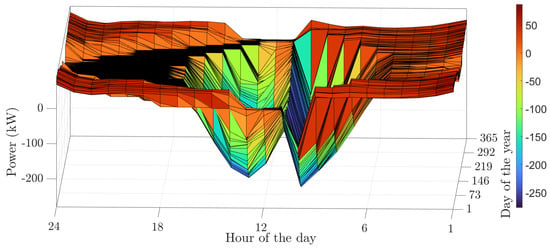
Figure 12.
Example of the total load of the transformer, including operation of BESSs; IN region; PV systems at the point of HC at around 163.7% (327 kWp); BESS penetration 100% (40× BESS 5 kW/13.5 kWh).
Furthermore, the heating types of customers highly affects the practicality of BESS. As Figure 13a indicates, BESS well suits customers with SH. The stored PV surplus is consumed by the late evening heating load, leaving the BESS empty before the next day’s sunshine hours. On the other hand, the low household consumption of customers using DH does not discharge BESS enough to fully participate in the absorption of the PV surplus. This is shown in Figure 13b and further elaborated in Section 3.5. For customers with DH, who do not posses an EV, a behavior strategy sending some of the accumulated energy to the network would be suitable.

Figure 13.
Example of the change of BESS SoC of a customer with Storage Heating (SH) (a) and District Heating (DH) (b); PV systems at the point of HC; BESS 5 kW/13.5 kWh.
3.5. Controlled BESS
To acquire the full potential of BESS, more advanced strategies are used. Based on the predictions and optimal utilization of the available power and capacity, the PV peak can be flattened by timely adjusted BESS operation. To explore their full potential, BESS behavior strategy used in this subsection has been adjusted so that the BESSs are forced to discharge to the SoC of 10% at early morning. The HC values of the newly defined BESS strategy are presented in Table 11. The results show significant increase of PV HC in all regions. A comparison with results of only partial utilization of BESS presented in Table 10 display an increase of the PV HC in PR region of 76.8%. In the IN region, PV HC increased by 28.3% and in the PU region by 103.8%.

Table 11.
PV HC of networks, including controlled BESSs (Overvoltage (E3), Transformer capacity (E7)).
3.6. Controlled Charging of EVs and Uncontrolled BESSs
Combined ownership of both EVs and BESSs is expected in the future distribution networks and is therefore investigated in this subsection. Previously studied penetration levels of uncontrolled BESSs (that are not forced to discharge during nights) and EVs (that utilize daily controlled charging) are combined and the synergy of the two is analyzed. The results are presented in Table 12. In the PR region, the combination of BESSs and EVs led to higher PV HC than if only one of these systems is used. When the PC fleet consists of only BEVs and BESS penetration is at 100%, the PV HC of 110.8% is achieved. This is an increase of 52.2% comparing the impact of BESSs only and 197% comparing the reference case.

Table 12.
PV HC of networks, including daily controlled charging of EVs and BESSs (Undervoltage (E2), Overvoltage (E3), Voltage unbalance (E4), Transformer capacity (E7)).
The PV HC increase caused by the cooperation might be explained by the BESS behavior strategy that does not force discharging before the peak of PV production. Due to this strategy, the BESSs of customers with district heating and without EVs are still partly charged before the PV peak in summer (see Figure 13b). As around one-half of all customers in this region use district heating, the addition of EVs foster the discharging of BESSs and so they can absorb more energy from PV surplus.
The cooperation might also be beneficial due to the sparse population of the PR region and relatively high presence of 1-phase EV chargers. With only 1 customer per node, overvoltage (E3) has traditionally been a key issue. Even if a very high level of EV penetration is assumed, on average, 62% of these EVs will by charged by a 1-phase charger. Therefore, even if several of these EVs are charged around noon, more than half of these BEVs will draw electricity and lower voltage only in one phase. Since there is only one customer, the difference between phase voltages cannot be balanced, the overvoltage in the remaining two phases persists and the PV HC is very unlikely to be increased. However, when BESSs are present, their tendency to reduce voltage differences may partly mitigate this problem and may lead to higher PV HC.
In the IN region, the cooperation increase of PV HC on average up to 197.8%. That is an increase of 20.8% compared to the BESS-only case and up to 67.3% compared to the reference case. Increase of penetration of both EVs and BESS mitigate overvoltage (E3) issues and foster problems with transformer capacity (E7). Similar to the PR region, the increase may be caused by more efficient usage of BESSs of customers with district heating, who represent one-half of all customers in the region. Since the PV HC increase is only 20% compared to the BESS-only simulations, this might be the major mechanism causing the increase. As in the previous regions, the increase in the PU region has its foundation in more intensive discharging of BESSs of customers with district heating. Its magnitude arises from the fact that 95.3% of the customers use district heating.
3.7. Controlled Charging of Both EVs and BESSs
A fruitful coexistence of BESSs and EVs was found so far. As the main process increasing the HC was identified to be the discharging of BESSs due to EVs preferring BESSs over the network. To see if there is also alternative processes increasing PV HC, an impact of BESSs that are fully discharged before the PV peak has been studied; this relates to Section 3.5, where the same BESS behavior strategy was used, but EVs were not present. The HC values reach the levels of the controlled battery case and are presented in Table 13. Once again, the numerical results of the EV impact on HC proves that the EV availability is crucial in increasing the HC. Travelling electric vehicles provide little help in absorbing PV surplus, and thus, the results are of the same magnitude of the BESS case. The effect of vehicle availability on the HC is analyzed in the next section.

Table 13.
PV HC of networks, including daily controlled charging of EVs and BESSs utilizing their full potential; PC fleet: All BEVs; (Undervoltage (E2), Overvoltage (E3), Transformer capacity (E7)).
4. Sensitivity Analyses
In this section, three sensitivity analyses are presented. First, the required number of iterations for the Monte Carlo simulation is determined. Then, the impact of vehicle availability on the hosting capacity is analyzed, followed by the analysis of the optimal storage size.
4.1. The Number of Iterations
An optimal number of iterations provide a trade-off between confidence of the result and computation time. The study presented in [5] exploited 1000 iterations. However, an analysis was conducted in the current study to support the optimal number of iterations. Various numbers of iterations ranging from 10 to 1000 were selected and 20 simulations were performed for each. The analysis results shown in Figure 14 indicate that 1000 iterations provide sufficient confidence of the result. Moreover, even 500 iterations are sufficient to draw confident results. Due to the varying computational complexity of the simulations in the current study, the number of iterations is different for every simulated case. The exact number of iterations is specified in the text and is typically 500 or 1000.
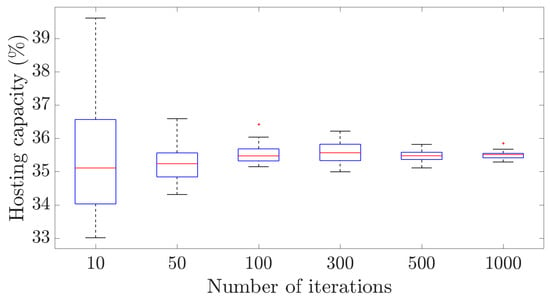
Figure 14.
Impact of the number of iterations on the simulation accuracy.
4.2. Vehicle Availability
Controlled charging of EVs, together with their daily usage results in very mild effect on PV HC. However, not every EV can be expected to be used every day. Low presence of EVs in the network at critical hours around noon seems to be the key obstacle limiting the increase of PV HC. Thus, if some of the EVs remain connected to the grid, the constraint can be overcame. This originates from the utilized vehicle-to-grid-based controlled charging strategy, that designates an EV to stay connected all day, charge/discharge the EV’s battery to SoC 80%. These EVs can be charged again (i.e., charged over SoC 80%) only by PV surplus after 10:00. This ensures that local electricity consumption will be increased during the worst hours to absorb excessive PV generation.
Figure 15a shows that an increase in the number of EVs that remain connected to the network all day has a positive impact on PV HC. The smallest increase in PV HC can be seen in the IN region, where PV HC 172.5% was reached. This increase of 46% compared to the reference case was achieved when every EV in the network has probability 80% that it would be connected to the network all day (i.e., will not be used for traveling). The highest increase was in the PU region where PV HC increased by up to 141% compared to the reference case. Figure 15b confirms the expected—more EVs with a higher probability that EVs remain connected all day increase PV HC. While PC fleet in 2030 in the IN region reached PV HC 123.1% (around 4 percentage point increase compared to the reference case) when the probability that EV remains connected all day was 80%, PC fleet All BEVs reached PV HC 172.5% (increase by 46 percentage points compared to the reference case).

Figure 15.
Impact of the probability that EV remains connected all day on PV HC. Note that the reference case HCs: PR = 37.2%; IN = 118.2%; PU = 86.6%. (a) Regional difference with PC fleet: All BEVs. (b) PC fleet difference in IN region.
Higher presence of EVs in the examined hours also alter structure of critical constraints. The following changes of the constraints were observed in the case of 80% probability that EV remains connected all day. In PR region, where overvoltage (E3) was used to dominate, problems with voltage unbalance (E4) and undervoltage (E2) appeared limiting 16% and 6% of iterations, respectively. Overvoltage (E3) became more prominent also in the IN region, where it represented PV HC limitation in 39% iterations. Changes can be seen in the limiting constraints of the PU region. The transformer capacity (E7) is a limiting constraint in 57% of the cases. Due to a remarkably long computation time, only 200 iterations were performed for the PU, while the other regions had 500 trials.
4.3. Optimal Storage Size
The impact of BESSs on PV HC varies along with its two main parameters—rated power and capacity. In order to inspect the impact, a 2-D analysis examining changes of BESS power in the range of 1 to 12 and BESS size in the range of 5 to 20 have been conducted. These ranges were chosen as they are close to the initially analyzed parameters—5 kW and 13.5 kWh. The results in Figure 16 show that an increase of BESS-rated power, together with its capacity, almost always results in higher PV HC. However, an increase of the rated power with constant capacity may even be counter-productive, as can be noticed at the impact of the increase of the rated power with constant capacity around 5 kWh. Moreover, the analysis shows that an optimal combination of BESS power and capacity can be found. The identified formula—Optimal Capacity = 1.875 · Rated Power + 3.008—predicts for previously used BESS power 5 kW an optimal capacity 12.4 kWh; that is very close to the previously utilized BESS capacity 13.5 kWh.
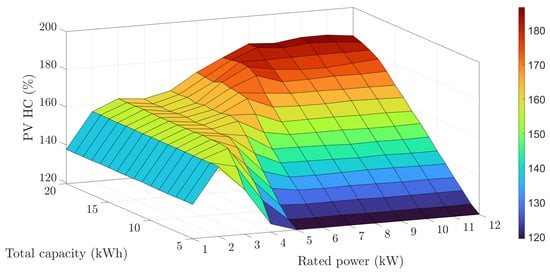
Figure 16.
Analysis of the impact of change of BESS power/size on PV HC; IN region; 100% BESS penetration; 500 iterations per analyzed combination.
5. Feasibility Analysis of BESS Utilization
In this section, a feasibility analysis was conducted to lay out the cost effectiveness of BESS implementation in order to increase PV HC. Only the predominantly rural (PR) region was considered due to the possibility to perform a large number of simulations in an acceptable time, while revealing the main impacts of the BESS. Moreover, since BESSs are not the only option to increase PV HC, they are compared with another ubiquitous alternative—network reinforcement. These two solutions are then economically compared with the value of electricity that is produced due to the PV HC increase.
This study compares the impacts of various combinations of 13 transformers ranging from 50 kVA to 3150 kVA [13] and 9 different cables with cross-sections from 35 mm to 300 mm [14]. Assuming the same cable size for a whole network, all the possible combinations of transformers and cable sizes were simulated, summing up to 117 combinations of network components. The costs, based on an Energy Authority document [26], were scaled up to better match the resulting prices. The costs of cables in the document have been multiplied by 3 to take into account the substantial cost of the installation. Transformer costs have been multiplied by 1.3 to take into account the cost of auxiliary equipment with transformer. Furthermore, the value of increased PV HC assumes that all the extra electricity produced can be sold to the network for the same price as consumers pay when they import electricity from the network. Furthermore, the constant price of electricity and money is assumed. Last but not least, an ideal solar conditions with annual gain 1955 kWh/kWp were assumed.
The simplified analysis of cost of BESS implementation was based on prices of residential BESSs. The installation of Tesla Powerwall 2, which has similar parameters to the BESSs considered in the current study, costs USD 10,500 [27]. Thus, the price of one BESS in euros is assumed to be EUR 8900. The analysis simulates a PR region with 8 customers, where the 100% penetration refers to 8 BESSs. The evaluation of the increase of PV HC is based on the differences between amounts of electricity generated by PV systems at the point of HC. It is assumed that PV surplus can be supplied to the network and has the same value as if it is drawn from the network. In accordance with the tax-less average price of kWh of electricity in Finland in June 2021, EUR 5.57 cents per kWh is assumed [28]. Electricity produced in 10 years is considered as Tesla, as well as several other manufacturers, provides a warranty for this period [29].
The comparison of the price of reinforcement and BESS solutions is shown in Figure 17. Utilization of both studied methods for PV HC increase—grid reinforcements and usage of BESSs—cost more than is the value of electricity that would be generated, if PV HC is increased. Even though from the DSOs point of view it is not profitable, the utilization of BESS that are forced to discharge before the PV peak are a cost effective way to increase PV HC.
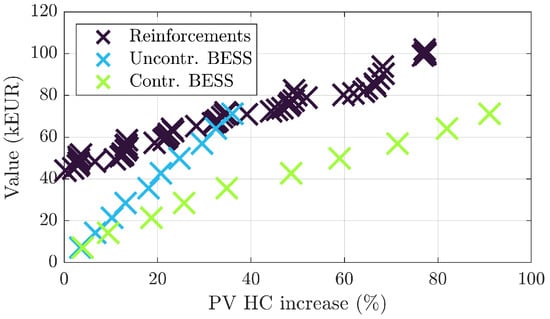
Figure 17.
The cost efficiency of network reinforcement vs. BESS; PR Region.
6. Conclusions
This article studied electric vehicles and energy storage to reveal the synergy in increasing PV hosting capacity. A Monte Carlo simulation was utilized to analyze low-voltage distribution networks representing three regions of Finland. The proposed framework utilized data published by authorities and institutions of Finland, and the results of the base case reflect the HC presented in [5]. The impact of BESSs and EVs on the hosting capacity and the results of several sensitivity analyses are summarized in Table 14.

Table 14.
Summary table of the main findings.
As the reference case results revealed, EVs alone have a negligible effect on the HC in residential networks. Generally, vehicles are used during the day to commute to work and the EVs are not plugged in. Due to the missing cars at noon hours, the absorption of the solar peak generation is not possible. In that case, the HC is directly correlated with the load of a network since a higher load absorbs the PV excess generation and grants higher HC. Moreover, the controlled charging of the EVs does not improve the availability, gaining a 12% HC increase on average compared to the reference case. The analysis of battery storage showed that the HC could be increased by 58% on average. District heated customers gain the least from the storage compared to storage heating due to the smaller consumption. The BESS is discharged less by the household demand before the sunshine hours. However, a charging strategy can increase the HC by 170% on average. Deliberately lowering the SoC of batteries before the sunshine peak hours would allow absorbing more excess PV generation. In fact, the analysis of the power and capacity indicated that the BESS model chosen for the current study has a well sized ratio of power and capacity for the modeled networks, and matches the typical household consumption pattern of Finland.
The synergy is disclosed when both EV and BESS are owned by households. Uncontrolled charging of both has an HC increase of 136%. Controlled charging, however, shows the same increase of the HC reaching 170%. The PV generation peak is shaved by the BESS, which is then discharged into the EV during the night hours, leaving the SoC low for the next day regardless of customer’s heating type. Furthermore, assuming that more people will work from home in the future, analysis of the EVs parked and connected to a network at home during a day shows an increase of the HC by an additional 83% on average. Finally, a comparative analysis indicated that BESSs are a cost efficient alternative to increase HC as compared to network reinforcement from a DSO perspective.
The method employed in the current study has proven to deliver a deterministic and fast solution for hosting capacity studies. The worst case hour allows to efficiently indicate the critical point of interest, avoiding calculating all the hours in a year. However, due to the non-existence of a planning horizon in the employed method, a BESS charging strategy ensuring even flattening of the peak within a day was not employed. As previously illustrated in Figure 12, the absorption of the PV surplus shaves the highest peak, leaving two lower peaks of the PV generation. In order to analyze more sophisticated battery charging control, the deterministic load flow calculations based on the worst case hour should be abandoned. Instead, an approach based on an optimal power flow could be employed. Optimization would grant a global maximum solution of the HC and would allow modeling battery control with a rolling horizon to distribute battery charging evenly within a day.
Author Contributions
The authors have contributed to the current study as follows: Conceptualization, M.P. and M.L.; methodology, V.P. and M.L.; software, R.F. and V.P.; validation, V.P., M.P. and M.L.; formal analysis, R.F.; investigation, R.F.; resources, R.F.; data curation, M.L.; writing—original draft preparation, R.F.; writing—review and editing, V.P.; visualization, R.F.; supervision, M.P. and M.L.; project administration, M.P. and M.L.; funding acquisition, M.P. and M.L. All authors have read and agreed to the published version of the manuscript.
Funding
This work was supported by Aalto University of Finland as a part of “SolarX” project 211763 funded by Business Finland, and by the Ministry of Education, Youth and Sports of the Czech Republic under BUT specific research programme (project No. FEKT-S-20-6449) in the Centre for Research and Utilization of Renewable Energy (CVVOZE).
Data Availability Statement
Not applicable.
Acknowledgments
This research work has been carried out in the Centre for Research and Utilization of Renewable Energy (CVVOZE). Authors gratefully acknowledge financial support from the Ministry of Education, Youth and Sports of the Czech Republic under BUT specific research programme (project No. FEKT-S-20-6449). The work was conducted during the Erasmus+ exchange program.
Conflicts of Interest
The authors declare no conflict of interest.
Abbreviations
The following abbreviations are used in this manuscript:
| BESS | battery energy storage system | |
| BEV | battery electric vehicle | |
| BTM | behind-the-meter | |
| DEH | direct electric heating | |
| DH | district heating | |
| DSO | distribution system operator | |
| E1 | load flow convergence violation | |
| E2 | undervoltage | |
| E3 | overvoltage | |
| E4 | negative sequence voltage unbalance | |
| E5 | cable ampacity violation | |
| E6 | neutral wire ampacity violation | |
| E7 | transformer capacity exceeded | |
| EV | electric vehicle | |
| HC | hosting capacity | |
| IN | intermediate | |
| LV | low-voltage | |
| NUTS | nomenclature of territorial units of statistics | |
| PC | passenger car | |
| PHEV | plug-in hybrid electric vehicle | |
| PR | predominantly rural | |
| PU | predominantly urban | |
| PV | photovoltaic | |
| SH | storage heating | |
| SoC | state of charge | |
| no-load losses | W | |
| load losses | W | |
| rated apparent power | kVA | |
| hosting capacity | % |
References
- IRENA. Renewable Power Generation Costs in 2019; Technical report; International Renewable Energy Agency: Abu Dhabi, United Arab Emirates, 2020. [Google Scholar]
- Eldeeb, H.H.; Faddel, S.; Mohammed, O.A. Multi-Objective Optimization Technique for the Operation of Grid tied PV Powered EV Charging Station. Electr. Power Syst. Res. 2018, 164, 201–211. [Google Scholar] [CrossRef]
- Shabbir, N.; Kütt, L.; Daniel, K.; Astapov, V.; Raja, H.A.; Iqbal, M.N.; Husev, O. Feasibility Investigation for Residential Battery Sizing Considering EV Charging Demand. Sustainability 2022, 14, 1079. [Google Scholar] [CrossRef]
- Carollo, R.; Chaudhary, S.K.; Pillai, J.R. Hosting capacity of solar photovoltaics in distribution grids under different pricing schemes. In Proceedings of the 2015 IEEE PES Asia-Pacific Power and Energy Engineering Conference (APPEEC), Brisbane, Australia, 15–18 November 2015; Volume 3, pp. 1–5. [Google Scholar] [CrossRef]
- Arshad, A.; Püvi, V.; Lehtonen, M. Monte Carlo-Based Comprehensive Assessment of PV Hosting Capacity and Energy Storage Impact in Realistic Finnish Low-Voltage Networks. Energies 2018, 11, 1467. [Google Scholar] [CrossRef]
- Hes, S.; Kula, J.; Svec, J. Increasing of Renewables Hosting Capacity in the Czech Republic in terms of European Project InterFlex (Case Study). In Proceedings of the Conference on the Industrial and Commercial Use of Energy, ICUE, Cape Town, South Africa, 13–15 August 2019. [Google Scholar] [CrossRef]
- Ulasenka, A.; Gastalver-Rubio, A.; Del Rio Etayo, L.; Cirujano-Ballesteros, P.; Ortiz-Gil, A.; Morales-Wagner, D.; Señas-Sanvicente, D.; Montoya, J.; Heussen, K. Coordinated operation of distributed energy resources to enhance local flexibility. IET Conf. Publ. 2020, 2020, 357–360. [Google Scholar] [CrossRef]
- Pieltain Fernandez, L.; Gomez San Roman, T.; Cossent, R.; Mateo Domingo, C.; Frias, P. Assessment of the Impact of Plug-in Electric Vehicles on Distribution Networks. IEEE Trans. Power Syst. 2011, 26, 206–213. [Google Scholar] [CrossRef]
- Zhou, X.; Zou, S.; Wang, P.; Ma, Z. ADMM-Based Coordination of Electric Vehicles in Constrained Distribution Networks Considering Fast Charging and Degradation. IEEE Trans. Intell. Transp. Syst. 2021, 22, 565–578. [Google Scholar] [CrossRef]
- Ekstrom, J.; Koivisto, M.; Mellin, I.; Millar, R.J.; Lehtonen, M. A Statistical Model for Hourly Large-Scale Wind and Photovoltaic Generation in New Locations. IEEE Trans. Sustain. Energy 2017, 8, 1383–1393. [Google Scholar] [CrossRef]
- Viotto, M. Present Status of DG in Germany: National Codes, Standards, Requirements and Rules for Grid-Interconnection and Operation; Technical Report; Cigreindia: Kassel, Germany, 2005; pp. 1–27. [Google Scholar]
- Arshad, A.; Lehtonen, M. A Stochastic Assessment of PV Hosting Capacity Enhancement in Distribution Network Utilizing Voltage Support Techniques. IEEE Access 2019, 7, 46461–46471. [Google Scholar] [CrossRef]
- Liquid-Filled Distribution Transformers. Available online: https://new.abb.com/docs/librariesprovider95/energy-efficiency-library/ecodesign{%}5C{_}dtr-30-06-2015.pdf?sfvrsn=9 (accessed on 1 June 2021).
- AXMK-PLUS 4-Johtiminen: Alumiinijohtiminen PEX-Eristeinen Halogeeniton 1 kV Voimakaapeli. Available online: https://fi.prysmiangroup.com/sites/default/files/business{_}markets/markets/downloads/datasheets/cprAXMK-PLUS220219.pdf (accessed on 1 June 2021).
- Degefa, M.Z. Energy Efficiency Analysis of Residential Electric End-Users: Based on Statistical Survey and Hourly Metered Data. Ph.D. Thesis, Aalto University, Helsinki, Finland, 2010. [Google Scholar]
- Autoalan Käyttövoimatiekartta 2021: Autokannan Käyttövoimaennusteet—Henkilö-, Paketti-, Kuorma- Ja linja-Autojen Käyttövoimien Muutokset Vuoteen 2040. Autoalan Tiedotuskeskus. Available online: https://www.aut.fi/files/2356/Kayttovoimatiekartta{_}raportti{_}1502{_}2021.pdf (accessed on 1 June 2021).
- Passenger Cars M1: EU Top 10 Models New Registrations Electricity. 2020. Available online: https://www.eafo.eu/vehicles-and-fleet/m1{%}5C{#} (accessed on 1 June 2021).
- Dílcí Studie pro Pracovní tým A25—Predikce Vývoje Elektromobility v CR. Available online: https://www.mpo.cz/assets/cz/energetika/strategicke-a-koncepcni-dokumenty/narodni-akcni-plan-pro-chytre-site/2019/10/Studie-NAP-SG-A25_Elektromobilita.pdf (accessed on 1 June 2021).
- Lehtinen, O.; Pitkaniemi, S.; Weckman, A.; Aikio, M.; Mabano, M.; Lehtonen, M. Electric Vehicle Charging Loads in Residential Areas of Apartment Houses. In Proceedings of the 2020 21st International Scientific Conference on Electric Power Engineering (EPE), Prague, Czech Republic, 19–21 October 2020; pp. 1–6. [Google Scholar] [CrossRef]
- Qian, K.; Zhou, C.; Allan, M.; Yuan, Y. Modeling of Load Demand Due to EV Battery Charging in Distribution Systems. IEEE Trans. Power Syst. 2011, 26, 802–810. [Google Scholar] [CrossRef]
- Traficom. Finnish National Travel Survey 2016; Technical Report; Finnish Transport Agency, Traffic and Land Use: Helsinki, Finland, 2018. [Google Scholar]
- Lajunen, A. Evaluation of energy consumption and carbon dioxide emissions for electric vehicles in Nordic climate conditions. In Proceedings of the 2018 Thirteenth International Conference on Ecological Vehicles and Renewable Energies (EVER), Monte-Carlo, Monaco, 10–12 April 2018; pp. 1–7. [Google Scholar] [CrossRef]
- Uimonen, S.; Lehtonen, M. Simulation of Electric Vehicle Charging Stations Load Profiles in Office Buildings Based on Occupancy Data. Energies 2020, 13, 5700. [Google Scholar] [CrossRef]
- IRENA. Innovation Landscape Brief: Behind-the-Meter Batteries; International Renewable Energy Agency: Abu Dhabi, United Arab Emirates, 2019. [Google Scholar]
- Kim, N.-K.; Cha, H.-J.; Seo, J.-J.; Won, D.-J. SOC management algorithm of battery energy storage system for PV ramp rate control. In Proceedings of the 2017 6th International Youth Conference on Energy (IYCE), Budapest, Hungary, 21–24 June 2017; pp. 1–6. [Google Scholar] [CrossRef]
- Regulation Methods in the Fourth Regulatory Period of 1 January 2016–31 December 2019 and the Fifth Regulatory Period of 1 January 2020–31 December 2023: APPENDIX 2; Technical Report; Energy Authority: Helsinki, Finland, 2015.
- Design Your Solar + Powerwall System. Available online: https://www.tesla.com/energy/design (accessed on 1 June 2021).
- Sähkön Pörssihinnat: Kuukauden Keskihinnat. Available online: https://www.pks.fi/sahkotarjoukset/kotiin/sahkotuotteet/priima-alykkaampi-sahko/?gclid=Cj0KCQjw{_}8mHBhClARIsABfFgpiWs3Of1BMQFjGhOvSLgF2{_}liwSExOwUQe8rGpN3BHJycAAELlyzYAaArIUEALw{_}wcB (accessed on 1 June 2021).
- Lane, C. Tesla Powerwall: Is It the Best Solar Battery? Available online: https://www.solarreviews.com/blog/is-the-tesla-powerwall-the-best-solar-battery-available (accessed on 1 June 2021).
Publisher’s Note: MDPI stays neutral with regard to jurisdictional claims in published maps and institutional affiliations. |
© 2022 by the authors. Licensee MDPI, Basel, Switzerland. This article is an open access article distributed under the terms and conditions of the Creative Commons Attribution (CC BY) license (https://creativecommons.org/licenses/by/4.0/).